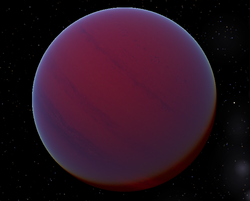HD 29587
| Observation data Epoch J2000 Equinox J2000 | |
|---|---|
| Constellation | Perseus |
| Right ascension | 04h 41m 36.31645s[1] |
| Declination | +42° 07′ 06.4209″[1] |
| Apparent magnitude (V) | 7.29[2] |
| Characteristics | |
| Spectral type | G2 V[3] |
| B−V color index | 0.633[3] |
| Astrometry | |
| Radial velocity (Rv) | +112.67±0.20[1] km/s |
| Proper motion (μ) | RA: +534.004[1] mas/yr Dec.: −414.768[1] mas/yr |
| Parallax (π) | 36.3130 ± 0.0697 mas[1] |
| Distance | 89.8 ± 0.2 ly (27.54 ± 0.05 pc) |
| Absolute magnitude (MV) | 5.08[3] |
| Orbit[4] | |
| Period (P) | 1,474.9±10.2 d |
| Eccentricity (e) | 0.356±0.095 |
| Periastron epoch (T) | JD 2,447,763.5±45.8 |
| Argument of periastron (ω) (secondary) | 80.2±13.3° |
| Semi-amplitude (K1) (primary) | 1.02±0.16 km/s |
| Details[3] | |
| Mass | 0.78±0.03 M☉ |
| Luminosity | 0.798+0.040 −0.038 L☉ |
| Surface gravity (log g) | 4.54±0.22 cgs |
| Temperature | 5,709±35 K |
| Metallicity [Fe/H] | −0.51±0.05 dex |
| Age | 14.7+3.8 −2.7 Gyr |
| Other designations | |
| Database references | |
| SIMBAD | data |
| Exoplanet Archive | data |
HD 29587 is a Sun-like[6] star with a candidate brown dwarf companion[7] in the northern constellation of Perseus. It has an apparent visual magnitude of 7.29,[2] which means it is too faint to be viewed with the naked eye. Based upon an annual parallax shift of 36.3 mas,[1] it is located 89.8 light years away. The star is moving away from the Earth with a heliocentric radial velocity of +113 km/s,[1] having come to within 55.8 ly some 148,000 years ago.[2] It is a hyper-velocity halo[6] star moving at a rate of 170 km/s relative to the local standard of rest.[8]
This ancient star has a stellar classification of G2 V,[3] matching a G-type main-sequence star. It has 78% of the mass of the Sun and is radiating 80% of the Sun's luminosity from its photosphere at an effective temperature of 5,709 K.[3]
Formerly an IAU radial velocity standard, this star was found to have a variable radial velocity due to a suspected orbiting companion.[7] The a sin i value for the unseen object is 0.0957 ± 0.0108 AU (14.31 ± 1.62 Gm),[4] where a is the semimajor axis and i is the orbital inclination – providing a lower bound for the semimajor axis. The secondary object most likely has a mass in the range 41.0–97.8 MJ, making it a probable brown dwarf.[9]
| Companion (in order from star) |
Mass | Semimajor axis (AU) |
Orbital period (days) |
Eccentricity | Inclination | Radius |
|---|---|---|---|---|---|---|
| b | ≥0.78±0.03 MJ | ≥0.0957±0.0108 | 1,474.9±10.2 | 0.356±0.095 | — | — |
References
- ^ a b c d e f g h Brown, A. G. A.; et al. (Gaia collaboration) (August 2018). "Gaia Data Release 2: Summary of the contents and survey properties". Astronomy & Astrophysics. 616. A1. arXiv:1804.09365. Bibcode:2018A&A...616A...1G. doi:10.1051/0004-6361/201833051.
- ^ a b c Anderson, E.; Francis, Ch. (2012). "XHIP: An extended hipparcos compilation". Astronomy Letters. 38 (5): 331. arXiv:1108.4971. Bibcode:2012AstL...38..331A. doi:10.1134/S1063773712050015. S2CID 119257644.
- ^ a b c d e f Da Silva, Ronaldo; et al. (2015). "Homogeneous abundance analysis of FGK dwarf, subgiant, and giant stars with and without giant planets". Astronomy & Astrophysics. 580: A24. arXiv:1505.01726. Bibcode:2015A&A...580A..24D. doi:10.1051/0004-6361/201525770. S2CID 119216425.
- ^ a b Halbwachs, J. L.; et al. (March 2000). "Exploring the brown dwarf desert with Hipparcos". Astronomy and Astrophysics. 355: 581–594. Bibcode:2000A&A...355..581H.
- ^ "HD 29587". SIMBAD. Centre de données astronomiques de Strasbourg. Retrieved 2018-08-02.
- ^ a b Fossati, L.; et al. (2017). "The effect of ISM absorption on stellar activity measurements and its relevance for exoplanet studies". Astronomy & Astrophysics. 601: 17. arXiv:1702.02883. Bibcode:2017A&A...601A.104F. doi:10.1051/0004-6361/201630339. S2CID 17549819. A104.
- ^ a b Mazeh; Latham, David W.; Stefanik, Robert P. (1996). "Spectroscopic Orbits for Three Binaries with Low-Mass Companions and the Distribution of Secondary Masses near the Substellar Limit". Astrophysical Journal. 466: 415–427. Bibcode:1996ApJ...466..415M. CiteSeerX 10.1.1.30.5905. doi:10.1086/177521.
- ^ Hobbs, L. M.; Duncan, Douglas K. (June 15, 1987). "The lithium abundance in halo stars". Astrophysical Journal, Part 1. 317: 796–809. Bibcode:1987ApJ...317..796H. doi:10.1086/165328.
- ^ a b Reffert, S.; Quirrenbach, A. (March 2011). "Mass constraints on substellar companion candidates from the re-reduced Hipparcos intermediate astrometric data: nine confirmed planets and two confirmed brown dwarfs". Astronomy & Astrophysics. 527: 22. arXiv:1101.2227. Bibcode:2011A&A...527A.140R. doi:10.1051/0004-6361/201015861. S2CID 54986291. A140.

